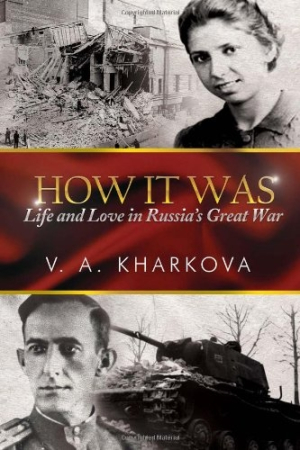How It Was
Life and Love in Russia's Great War
This book fills a knowledge gap in the English-speaking world—what life was like for a Soviet soldier and citizen during World War II.
Not surprisingly, most English-language books about World War II are written about the military campaigns of the Allied forces, the Holocaust, and life back at the home front. V. A. Kharkova’s How It Was: Life and Love in Russia’s Great War adds an important view of the war from the Soviet side through her experiences as a Moscow college student and her husband’s days as a soldier with the 5th Shock Army.
The author writes simply, but describes people and scenery with effective detail. Her wartime life seems like one unimaginable hardship after another, but there is no hint of complaint, only straightforward prose about sleeping in unheated rooms in winter (wearing all her clothes and a shot of vodka helped); having her studies interrupted by mandatory stints of logging, trench digging, and tree stump removal; finding adequate medical care for her younger brother after he was hit by a car; and earning extra food rations for her family by donating blood.
Even these bleak scenes pale when compared to the brutality that her future husband, Zhora, witnesses during the siege of Leningrad. He was a tank commander and allowed to go to Leningrad for replacement parts. His fellow soldiers provided food parcels for him to take back to their loved ones, and Zhora later told Vera about the horror of finding so many dead or orphaned. He ferried some weakened refugees out among his tank parts, only to have to bury one by the side of the road in the snow.
Despite the many awful scenes, the author’s tone remains optimistic. She remembers the beauty of strolling Moscow’s frozen streets and gardens during her courtship and the happy family parties and holiday celebrations. She is most enthusiastic when she writes about the thrill of falling in love, giving birth to her son, and seeing Zhora when he finally returned home to Moscow in 1946, though she sometimes relies too heavily on the exclamation point in conveying these joyful memories.
Vera doesn’t shy from relating unflattering details about her family and comrades. Her mother, widowed after her husband died in a labor camp, was given an offer from the police she couldn’t refuse and became an informant on her fellow churchgoers. She retells Zhora’s stories about Russian soldiers pillaging civilian homes as they marched toward Berlin and how they would pitch all the furnishings outside, preferring to sleep on bare floors because “they couldn’t bear the smell of German things.”
Family photographs add important detail to the author’s story and help keep track of her many family and friends. A foreword by the author’s daughter-in-law also provides background about the rest of Vera’s ninety-two years and the hardships her family suffered even before the war.
A family tree would have been a nice addition, not only because the abundance of Slavic names and naming conventions may be unfamiliar to Western readers, but also because everyone has a nickname as well. A map of Eastern Europe would have also been useful to identify the numerous towns mentioned, some of which are spelled differently on various maps or later changed names.
How It Was is a welcome addition to the literature of World War II. It is an eye-opening and vividly written firsthand account of how two Russians endured but also enjoyed life from 1941 to 1946, a pivotal era for the Soviet Union and for Vera and Zhora.
Reviewed by
Rachel Jagareski
Disclosure: This article is not an endorsement, but a review. The publisher of this book provided free copies of the book and paid a small fee to have their book reviewed by a professional reviewer. Foreword Reviews and Clarion Reviews make no guarantee that the publisher will receive a positive review. Foreword Magazine, Inc. is disclosing this in accordance with the Federal Trade Commission’s 16 CFR, Part 255.

